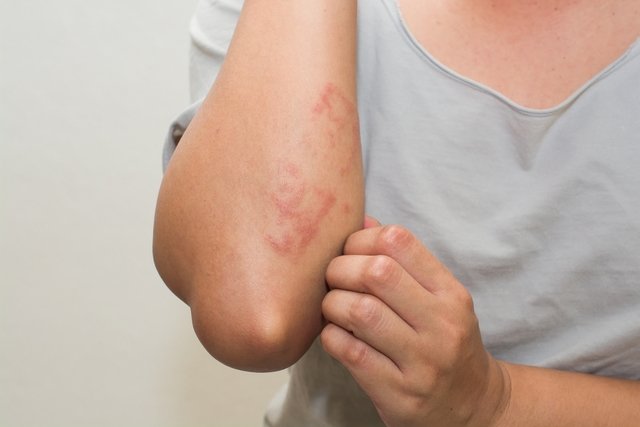Heat allergy is a type of skin irritation caused by an increase in body temperature, causing symptoms such as small red dots on the body, intense itching or burning and red spots on the skin.
Technically known as cholinergic urticaria, heat allergy can be caused by situations such as sun exposure, stress, physical exercise, hot baths, consumption of spicy or hot foods and alcoholic beverages, for example. Learn more about cholinergic urticaria.
Although this condition has no cure, heat allergy treatment helps to alleviate symptoms and must be guided by a dermatologist or allergist, and may include the use of corticosteroid or anti-allergy medications, such as hydroxyzine and cetirizine.

Main symptoms
The main symptoms of heat allergy are:
- Small red dots on the body;
- Intense itching or burning of the skin;
- Red plaques on the body;
- Diarrhea.
Additionally, in rarer cases, heat allergy can also cause more serious allergic reactions, including symptoms such as difficulty breathing, swelling of the lips, hands, feet, eyes or throat, and a drop in blood pressure.
Skin lesions rarely affect the palms of the hands, soles of the feet and armpits and generally disappear within a period of between 15 minutes and 1 hour.
Online symptom test
To find out if you may have an allergy, such as heat allergy, please select the symptoms you are experiencing:
This test is a tool that serves as a means of guidance only. Therefore, it is not intended to provide a diagnosis and does not replace consultation with an allergist, immunologist or general practitioner.
How the diagnosis is made
The diagnosis of heat allergy is made by a dermatologist, or allergist, by evaluating the lesions and the person’s health history.
To assess your risk of heat allergy, make an appointment with the dermatologist closest to you:
Taking care of your health has never been easier!
To confirm the diagnosis, the doctor can also perform a provocation test, which consists of causing an increase in body temperature, through physical exercise, such as cycling and treadmill, or a hot bath, for example, to assess the appearance of lesions.
Possible causes
Heat allergy can be caused by exposure to the sun, anxiety, stress, physical exercise, hot baths, consumption of spicy or hot foods and alcoholic beverages.
It is believed that heat allergy arises due to an exaggerated reaction of the immune system to substances present in sweat; due to the excess of receptors in the cells of the skin’s immune system; or as a result of increased body temperature, associated with sweating.
What is the treatment like?
Although there is no cure, the treatment of heat allergy includes the use of anti-allergy medications, such as hydroxyzine and cetirizine, which must be prescribed by a dermatologist and help to alleviate symptoms.
The doctor may also prescribe corticosteroid and immunobiological medications, such as omalizumab, and desensitization therapy, where the person is exposed to their own sweat to stimulate the body’s adaptation.
In addition, some measures that also help to avoid and control heat allergy are applying cold compresses to the lesion sites, avoiding saunas and hot baths, getting a good night’s sleep and avoiding the consumption of alcoholic or hot drinks and spicy foods, for example. example.
Bibliography
- BRAZILIAN ASSOCIATION OF ALLERGY AND IMMUNOLOGY. Urticaria. 2022. Disponível em: <https://asbai.org.br/wp-content/uploads/2022/09/EBOOK-ASBAI-URTIC%C3%81RIA_30-09-2022.pdf>. Acesso em 04 out 2023
- VHL PRIMARY HEALTH CARE. Is it possible for a person to have an allergy triggered by physical activity?. Available at: <https://aps-repo.bvs.br/aps/e-possivel-que-uma-pessoa-tenha-alergia-desencadeada-por-atividade-fisica/>. Accessed on October 4, 2023
- DERMNET- NEW ZEALAND DERMATOLOGICAL SOCIETY. Cholinergic urticaria. Available at: <https://dermnetnz.org/topics/cholinergic-urticaria>. Accessed on October 4, 2023
- FUKUNAGA, Atsushi et al. Cholinergic Urticaria: Subtype Classification and Clinical Approach. Am J Clin Dermatol. Vol.24. 1.ed; 41-54, 2023

Sign up for our newsletter and stay up to date with exclusive news
that can transform your routine!
Warning: Undefined array key "title" in /home/storelat/public_html/wp-content/plugins/link-whisper-premium/templates/frontend/related-posts.php on line 12
Warning: Undefined array key "title_tag" in /home/storelat/public_html/wp-content/plugins/link-whisper-premium/templates/frontend/related-posts.php on line 13



